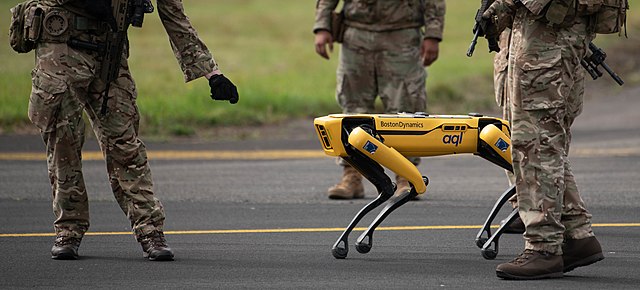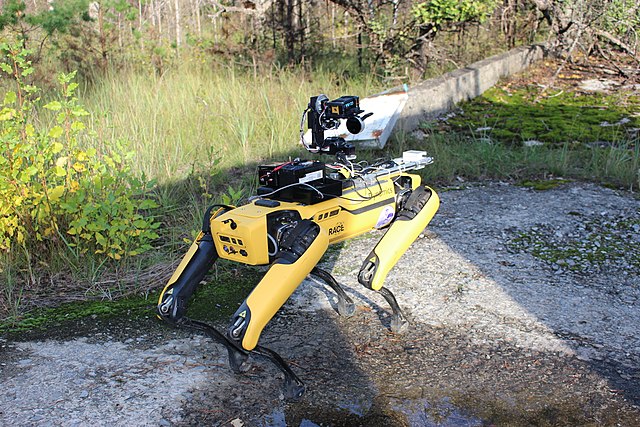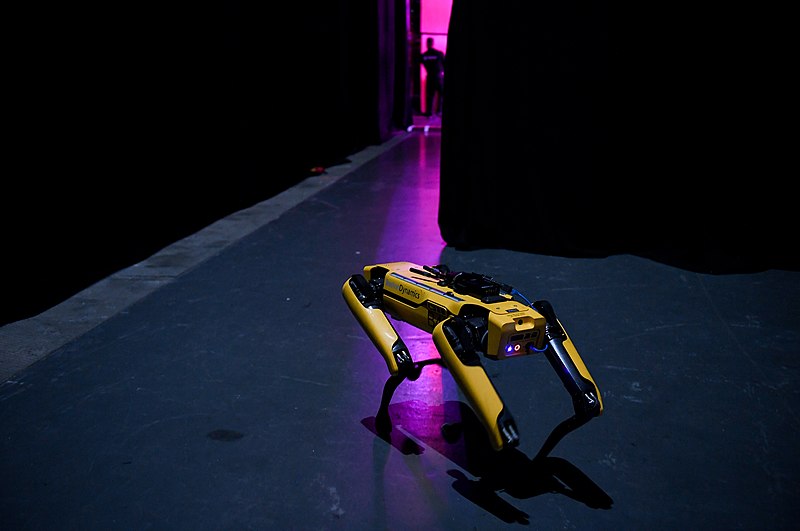Featured image credit: Web Summit
Well, we’re officially in the future. The Los Angeles Public Safety Committee voted on Tuesday, January 24 to approve the donation of a military-grade robotic canine to the Los Angeles Police Department. However, this doesn’t mean it’s a done deal. The approval must still clear a vote from the City Council. But given that the donated machine passed the committee vote with a landslide four-to-one result, City Council approval won’t come as a shock. Needless to say, the potential presence of a cutting edge robot police dog is courting controversy.
A Spot on LAPD’s Public Image?
As visions of vicious Terminator hounds lunge through your mind, you’re likely wondering: what exactly is a robot police dog? American engineering company Boston Dynamics created the controversial canine. And while they prefer the term “agile mobile robot”, the world will no doubt override this phrase in favor of “robot police dog.” The compromise? Boston Dynamics has dubbed their creation “Spot.”
The Los Angeles Times recently reported Spot’s precise measurements: a lean 70 pounds and 28 inches short. It sure doesn’t sound like a killer. Yet, this bot illustrates a striking agility in its quadrupedal manner sure to stoke a feeling of uncanny valley in all who behold it. It’s also capable of climbing stairs, opening doors, and beaming 360-degree video to its remote controllers from a carefully positioned camera in its head. And for many Angelenos, this is where an unsettling feeling starts to creep in.
That Robot Police Dog Won’t Hunt
Aesthetics aside, a robot police dog joining the LAPD highlights an ongoing nationwide controversy. Spot is simply the latest example of a civic police force utilizing military-grade equipment. So, what exactly does LAPD plan to do with a robot police dog?
Spot would join the LAPD’s SWAT unit. And, despite the dystopian reputation, officers would allegedly only use the robot police dog with non-violent intent. This is in strict adherence to Boston Dynamics’ terms of use. The Police Commission now has the challenge of trying to convince the average Angeleno that their mechanical canine isn’t “bark” or “bite”. Rather, it’s a precision-crafted surveillance tool.
LAPD want their robot police dog to come with the works. Frankly, there’s not much about the deluxe version of Spot that seems capable of mortal damage. LAPD’s Spot would include the arm that allows it to open doors. It would boast infrared vision capable of beaming thermal images back to officers. And it would make use of a mesh network expansion that opens up its range from the standard 164 feet to an impressive 3,341 feet.
Military-Grade Equipment in the Wake of AB 392

The LAPD has even gone so far as saying that a robot police dog would reduce the need for lethal force. But it’s not just the dog itself that urged concerned Angelenos to speak out before the January 23 vote. It’s the officers at the controls of the military-grade machine.
In 2019, Governor Gavin Newsom signed Assembly Bill 392 into law. It states that police can only utilize deadly force when “necessary in defense of human life.” Many Californians critical of the police force viewed the law as not going far enough to curb racially disproportionate deaths from police firearms. Meanwhile, certain police departments resented the implications of the bill. Most famously, the Pomona Police Department. At the end of 2022, a court of law ordered their officers to undergo official training in deadly force compliance. The lawsuit was the result of the Pomona Police Department’s largely dismissive attitude toward AB 392.
But even prior to AB 392’s passing, the LAPD had been under scrutiny for what critics deemed as excessive use of violence. Therefore, even though Spot the robot police dog was not designed with violent intentions, some citizens believe the officers behind the machine could lead it to violent ends.
Even looking at Spot through a pragmatic lens, there’s just no data to support that a robot police dog would prevent crime. The latest in facial recognition technology is still handicapped by a 34 percent higher failure rate for darker skinned females when compared to lighter skinned males. It’s not the best look for an organization already battling numerous allegations of racial discrimination.
The Prior Trials and Errors of Robot Police Dogs
Then, there’s the anecdotal evidence from other cities where similar robot police dog units were trialed. The NYPD briefly patrolled the streets aside Digidog, their blue robo canine. But after the programmed pooch was recorded prowling low income housing projects, public sentiment was less than forgiving. Following a critical tweet from Rep. Alexandria Ocasio-Cortez, the NYPD returned their robot police dog. The San Francisco Police Department’s plan to use robotics never even made it to the street. After it was leaked that they intended to use a machine capable of using a bomb to attack a suspect, public outrage canned the plan.
But as far back as last November, LAPD Chief Michael Moore has been adamant that the LAPD have closely observed and learned from these other city’s mistakes. First of all, the LAPD will be using Spot for a strictly specific set of hazardous scenarios. Secondly, they’ll only be using funds collected by the L.A. Police Foundation to pay for their robot police dog.
Remote Lack of Control

They may have miscalculated the public response to that second point. With the LAPD using their own funds, they’re not subject to the same kind of oversight they would be if they were using money from the general fund. Sure, taxpayers may not be exactly thrilled about $1,500 going toward customization of Spot so that the LAPD logo is proudly brandished on its mechanical leg. But some financial control could be a comfort if LAPD decides down the road to add a bomb deployment feature like San Francisco’s force considered.
It’s still unclear when the LA City Council will be reviewing this matter. In the meantime, Spot could make a day in the life of an LAPD officer much safer. Or it could usher in an episode of Black Mirror. We’ll likely find out sooner than later.


